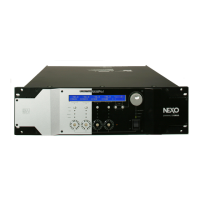NXES104 EXPANSION BOARD AND REMOTE CONTROL
you will find descriptions of cables listed for reasons of completeness, but that are not
suited for EtherSound networks.
CAT5, 5e, 6, 7 cables
Level 5 cable supports transmission rates of up to 100Mbps (200Mbps in full-duplex),
CAT5e, even 1Gbps - is the most common today. Category 6 supports up to 10Gbps, for
CAT6 and CAT7 new standards are under development.
Horizontal (solid) cable and patch (stranded) cable
Both UTP (Unshielded Twisted Pair) and STP (Shielded Twisted Pair) come in stranded and
solid wire varieties. The stranded wire is the most common and is also very flexible for
bending around corners. Solid wire cable has less attenuation and can span longer
distances, but is less flexible than stranded wire and cannot be repeatedly bent (and
therefore not suitable for live applications). Following are the twisted pair categories.
Horizontal cable (also called solid cable) is made of plain copper conductors and has a low
characteristics shift with aging. It must be used for long runs of steady cabling (typically
the cables inside walls and ceiling).
Patch cable (also called stranded cable), more flexible, is made of stranded copper
conductors and has larger losses and characteristics shifts than horizontal cable. It can be
used for versatile termination between wall outlet and device, or between devices. These
cables are explicitly labeled “PATCH”. The TIA/EIA 568A wiring standard allows the use of
horizontal cable up to 90m(295ft) lengths with a maximum amount of 10m of patch cable
for both ends added together.
UTP, FTP (ScTP), STP, SFTP cables
UTP stands for Unshielded Twisted Pair. It is a cable type with one or more pairs of twisted
insulated copper conductors contained in a single sheath. It is the most common type of
cabling used in desktop communications applications.
WARNING! For optimum performance sake and electromagnetism behavior, the
UTP cables shall NOT be used.
FTP stands for Overall Foil Shielded Twisted Pair (ScTP for Screened Twisted Pair): Cable is
wrapped with an aluminized plastic foil). That kind of cabling is not recommended for
applications where the cable is repeatedly bent. The foil tends to break leading to severe
loss of performance over the distance.
WARNING! Do not use FTP cabling for live application.
STP stands for Shielded Twisted Pair: Screen is made of copper braid. SFTP stands for
Overall Braid + Foil Shielded Twisted Pair: Foil screen and braid shield. For all these cables,
transmission characteristics are the same. The difference is the behavior with respect to
electromagnetic interference. We recommend cabling that has a superior quality sleeve in
PAGE 54 OF 80

